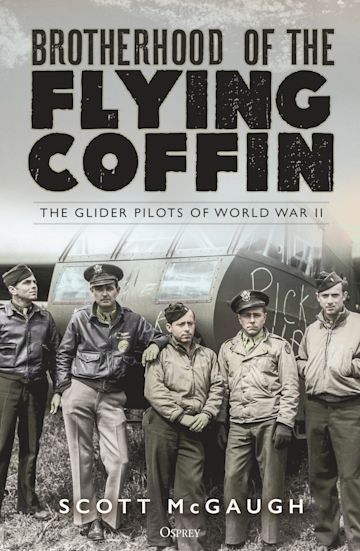Brotherhood of the Flying Coffin
- By Scott McGaugh
- Osprey Publishing
- 288 pp.
- Reviewed by Tom Young
- February 25, 2024
Meet the gutsy aviators who drifted silently into battle.

During World War II, there were no aircraft capable of dropping heavy equipment for an airborne invasion. Nowadays, if you need a truck or an artillery piece on the ground in a hurry, you can slide it out the back of a C-130 or a C-17. Giant parachutes will open and deliver it unbroken, right where you want it. But in the 1940s, you had to put that artillery piece, along with its crew, in a glider.
Simple, really. Just cut loose from the tow plane and crash-land in the middle of a firefight. If you can find pilots skilled and brave enough to do something that crazy. Author Scott McGaugh does those fliers a great service by telling their story in Brotherhood of the Flying Coffin: The Glider Pilots of World War II.
He tells the tale in chronological order. McGaugh describes the development of the Waco CG-4A glider, which could carry more than 3,700 pounds of troops and equipment. The design was contracted to more than a dozen companies, some of which had no experience building aircraft. One built a single glider at a cost of nearly $2 million. Surprisingly, the Gibson Refrigerator Company turned out to be one of the best glider producers.
The new technology required new procedures, and the book details the rush to train pilots for a mission expected to suffer a 50-percent casualty rate. A chapter titled “Crashing Is a Lonely Sound” mentions the wings earned by those pilots, which included a “G” in the center: “It really doesn’t stand for Glider,” many said. “The G is for Guts.”
Some of the pilots got their first taste of combat during Operation Husky, the invasion of Sicily during the summer of 1943. Anti-aircraft fire and rough weather plagued the mission, and scores of gliders were released over the water, farther out than their planned release point. Hundreds of men died, many by drowning. The disaster led to improved tactics and equipment, which were put to the test during Operation Overlord, the invasion of Normandy:
“Throughout the day, a glider’s tail slamming onto the ground signified a successful landing for the glider pilots who had put their glider up on its front skids to stop and risk a somersault. Some glider pilots felt as though they had survived a prize fight. Pinned by their seat belt, they had slammed against the side when a wing had been ripped away by a tree. Others had been yanked up and down as the glider had plowed across the field’s furrows. An immediate, pounding headache, blurred vision, and queasiness probably signified a concussion.”
Six weeks after D-Day, gliders flew again in Operation Dragoon, the invasion of southern France. Though commanders applied previous lessons learned, no glider mission came easily or without casualties. The enemy was learning, too. The author describes how what appeared in surveillance photographs as wine poles turned out to be four-by-four anti-glider poles, designed to rip the aircraft apart on landing.
Next came Operation Market Garden, an airborne assault in the Netherlands that involved multiple glider lifts. Bad weather again contributed to losses. McGaugh includes a description from Walter Cronkite, who rode in on a glider:
“Gliders were landing around us. But others came tumbling out of the sky. Two collided almost above us and a jeep, a howitzer, and soldiers came crashing down. A C-47 came low overhead, streaming smoke, and exploded in the woods just beyond. Another glider came straight down and plowed into the soft earth like an artillery shell.”
Vivid recollections such as Cronkite’s are a highlight of Brotherhood of the Flying Coffin. Other books have been written about glider operations, including John L. Lowden’s Silent Wings at War and Milton Dank’s The Glider Gang. McGaugh cites some of them as source material, and his work joins a growing canon in what for many readers is a lesser-known corner of WWII history.
Near the end of the war, gliders flew in Operation Varsity, the largest single-day airborne attack in history. According to McGaugh, on March 24, 1945, more than 900 American gliders and nearly 450 British gliders took part. Their mission involved putting two airborne divisions across the Rhine River, behind German lines. The operation succeeded — but with losses, as always. In just 12 hours, 86 glider pilots were killed.
One of the most salient quotes in Brotherhood of the Flying Coffin comes from General William C. Westmoreland of Vietnam fame. He described glider pilots this way: “They were the only aviators during World War II who had no motors, no parachutes, and no second chances.”
[Editor’s note: This review originally ran in 2023.]
Tom Young is the author of several military-related novels, including the World War II novels Silver Wings, Iron Cross and Red Burning Sky. Young spent more than 20 years with the Air National Guard, including service in Iraq and Afghanistan. He lives in Alexandria, VA.

